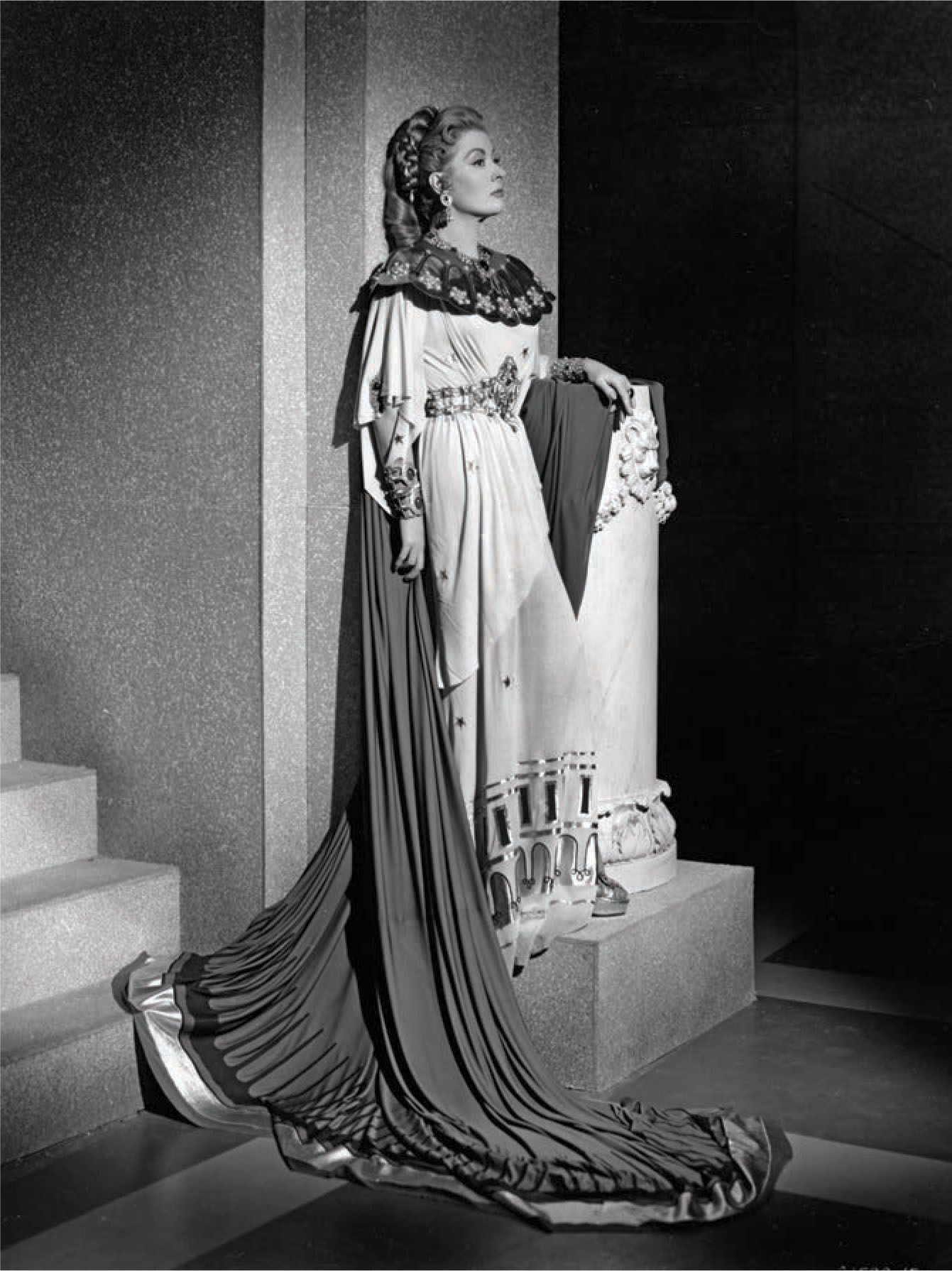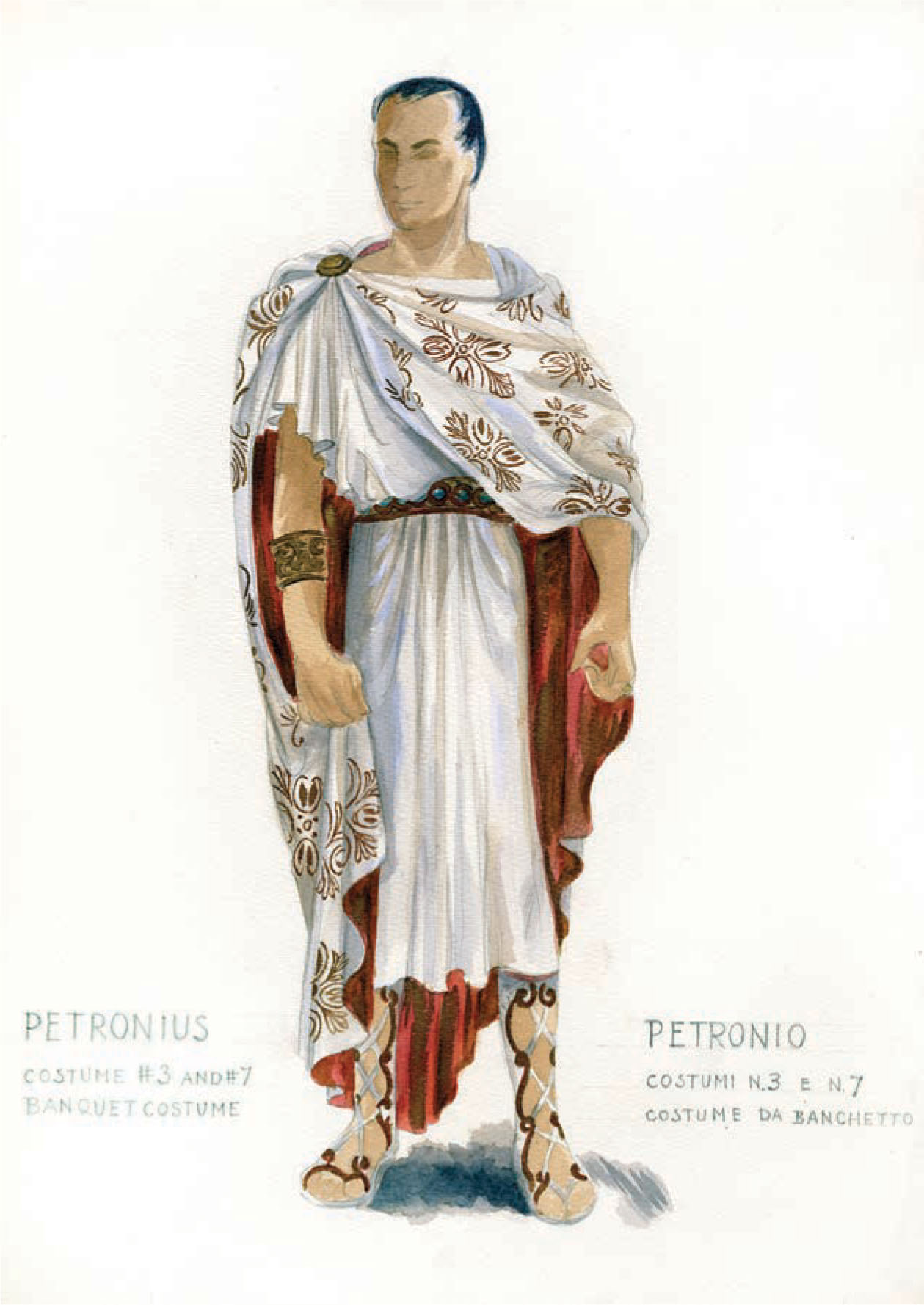Although Lana Turner was nominally the star of MGM’s lavish The Prodigal (1955), pre-release press coverage focused almost exclusively on the real stars of the cheesy Bible epic: the 2,600 period costumes designed by Herschel McCoy.
The critical praise seemed to confirm that Herschel was poised to become a truly great costumer after having spent a decade designing for dozens of forgettable B movies. But the promise of a great career was never realized; Herschel died less than a year later from acute pancreatitis and pulmonary edema, following surgery at UCLA Medical Center for an intestinal blockage.
Herschel’s interest in design dated back to his teen years in Mississippi. He was born there as Herschel D. McCoy on August 6, 1912. His father, William I. McCoy, was a hearing impaired accountant. His mother, Neva A. Burnett McCoy, worked as a milliner in a local shop. By the time Herschel and elder brother, Wilbur, were in grammar school, Neva had left the hat shop and was running a boarding house. Her earlier interest in apparel, however, had a lasting influence on Herschel. At fifteen, he persuaded his parents to let him quit high school in Meridian, Mississippi, and enroll in the New York School of Fine and Applied Arts (now Parsons The New School for Design). The school’s Paris atelier, established by William Odom in 1921, enabled Herschel to study abroad. While in Paris, he researched peasant costumes, traveling to far out-of-the-way spots. He also spent several months apprenticing in the ateliers of Schiaparelli and Patou.
Herschel returned to the United States and went to work for 20th Century-Fox. While some sources state that he began at Fox in 1931, his earliest film credits are for 1936 releases. Herschel himself said he started his career “at the start of the Depression.” Regardless of his start date, Herschel spent his years at Fox designing for serialized B movies, including the Charlie Chan and Mr. Moto series.
Herschel was a meticulous designer, often instructing his cutters in detail. For Tyrone Power’s wardrobe in Son of Fury (1942), he researched men’s clothes from 1790 and then did watercolor sketches for each of Power’s twenty-seven costumes. In his instructions to the tailors, he specified: “Bottom buttons, seven inches apart. Second set, seven and a half. Belt, two and a quarter inches wide. Fob three inches.” He included such instructions for each costume. The tailors cut and sewed, and then Power had to suffer through fittings for each of the costumes. And there were two copies of the suit he had to fight in—just in case he should split a seam before the scene was finished. There were six copies of a suit he had to swim in—just in case multiple retakes were needed. Two books were made for the wardrobe master, one of Power photographed in each costume, and one including continuity details. Because the movie was shot in several short sequences, detailed instructions were necessary so Power would not begin a scene in a tavern hanging up his derby, and five minutes later, leave with a topper.
While at Fox, Herschel often corroborated with Gwen Wakeling, with Herschel doing the men’s costumes and Wakeling the women’s. By the late 1930s, Herschel was financially comfortable. He moved his parents and brother from Mississippi to live with him in Westwood. A few years later, World War II ended Herschel’s tenure at Fox. He enlisted with the Army Corps of Engineers in 1942. His brother, Wilbur, died that same year, and his father died before the war ended, leaving his mother to again run a boarding house, this time for UCLA students. Herschel joined his mother in managing the boarding house after the war ended, until 1951, when he joined MGM as a designer.
At MGM, Herschel graduated to A-list movies. Quo Vadis (1951) required a staggering 15,000 costumes. The space needed to house the costumes and sets was truly epic. Herschel and a staff of eight designed elaborate period garments for Robert Taylor, Deborah Kerr, and hundreds of other actors. One dress worn by Kerr required four thousand tiny beads, each one applied individually by hand. Another gown, worn by Patricia Laffan as the Empress Poppaea, was fashioned from a specially woven fourteen-carat gold lamé material. Studio underwriters insured that gown for $1,000. Herschel received his first Academy Award nomination for his efforts. The Oscar went to Orry-Kelly, Walter Plunkett, and Irene Sharaff for An American in Paris.

Marlon Brando in costume for Julius Caesar (1953).

Greer Garson in Julius Caesar.
The following year, Herschel designed another period piece, Julius Caesar (1953), starring Marlon Brando, James Mason, Greer Garson, and Deborah Kerr. Although the Academy would pass over his work this time, the picture confirmed Herschel’s status as the go-to designer for all things classically Greek or Roman, an informal honor that he appreciated, but considered a handicap at times as films requiring ancient style did not come around often.
The Prodigal (1955), based on the New Testament parable, required even more lavish costumes than Quo Vadis. Herschel designed more than 2,600 costumes, including 292 changes for the principals alone. MGM spent $250,000 on wardrobe. One hundred people worked three months making Herschel’s creations. Turner’s $47,000 worth of costumes drew press attention as the “most revealing outfits” she had ever worn on film. Producer Charles Schnee insisted that the dresses Herschel had created for the platinum blonde were historically accurate re-creations of fashion circa 10 BC, based on then-recent archeological excavations near Persepolis, the ancient capital of Persia. Critics were not convinced. “One of the outfits has some beading on the top and a couple of scarves front and back,” one fashion pundit wrote. “That’s all, brother. The rest is all Lana.”
Turner herself loved the attention. Just before The Prodigal was released, Dior announced that he would be bringing back the flat-chested modes of the 1920s. Turner predicted Dior’s new line would bomb. “If a girl has ’em,” she said, “she’s not going to hide ’em. And if a girl hasn’t got ’em, she’ll use those rubber things.” As to her designer, Turner said, “He’s great. He didn’t mind a little editing here and there.” Turner explained that Herschel had agreed to remove the heavier beads from her outfit after she complained that the beading looked “big as a house.”

Lana Turner checks on the progress of a dress for The Prodigal in the workroom at MGM.

A Herschel McCoy costume sketch for Leo Genn in Quo Vadis (1951).
Herschel had just started working on Ben-Hur (1959) when he fell ill and was taken to UCLA. He died on February 3, 1956, at age forty-three, leaving Elizabeth Haffenden to finish Ben-Hur without him. Haffenden won the Oscar for her efforts at the 1960 Academy Awards.